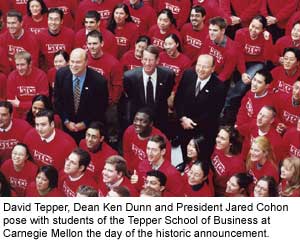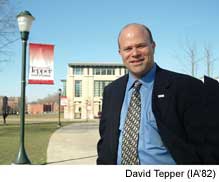Owning the space where business and technology intersect.
Tepper Takes B-School to the Big Leagues
According to one of his former students, Ken Dunn was always “ahead of his time” when he taught at the business school in the 1980s. Now, this former student wants to keep it that way. So he and his wife gave Carnegie Mellon the largest gift in its 104-year history—$55 million to the school of business, the second largest gift to any U.S. business school.

His name is David Tepper. That’s also the new name given to the Graduate School of Industrial Administration in recognition of the gift he and his wife, Marlene, gave to the business school that was originally founded by William Larimer Mellon in 1949.
Tepper says the gift will be used to make sure Carnegie Mellon continues to “teach things that aren’t in any textbook.” Dunn was doing just that when Tepper, now 46, was a graduate business student more than 20 years ago. Tepper says this was a very big reason he went on to build Appaloosa Management, a $3-billion hedge fund investment firm in Chatham, N.J.
“We say that our students make an impact in the world and we emphasize that with their ability to combine disciplines to solve problems and come up with new ideas, they make an impact more quickly than their peers,” said Carnegie Mellon University President Jared L. Cohon. “David epitomizes this kind of success. To receive this transformational gift from a recent graduate speaks to the competitive advantage our students possess.”

“The outstanding education I received at Carnegie Mellon gave me the ability to analyze investment options in such a unique way that I am still capitalizing on what I learned there to this day,” Tepper said. “I owe a lot to my former professor, Dean Ken Dunn, and the rest of the faculty.”
Tepper’s gift acknowledges more than five decades of landmark accomplishments in leading new approaches to management research and education. And it supports the business school’s initiatives to build upon its environment of academic rigor, excitement and discovery.
“Pioneering efforts are not new to Carnegie Mellon,” said Ken Dunn, dean of the Tepper School of Business.
Management science was invented here by an academic “dream team” whose philosophy of preparing future business leaders by using an analytical decision making approach to more effectively manage an uncertain, dynamic marketplace was vastly different from the conventional reliance on a case study method that, in their opinion, did not deepen one’s problem-solving abilities.
During the b-school heyday of the 1950s and 1960s, Carnegie Mellon’s business faculty—which included a roster of maverick visionaries named Bach, Cooper, Cyert, Miller, Modigliani and Simon who went on to become university presidents and Nobel Laureates—served as the source of management knowledge for other leading American business schools. As the late Herb Simon, former professor and Nobel Laureate, put it, “intellectual excitement was the commodity we marketed.”
The Tepper gift will nearly double the endowment of the business school and will inspire others to support this distinctive institution that uses its collaborative, multidisciplinary culture to produce innovations with impact.
“Their gift accelerates our vision of owning the space where business and technology intersect,” said Dunn. “Marlene and David Tepper’s generosity—and belief in the strength of the school—will have a lasting impact. They expect a return on their investment, and rightly so. They expect the school to retain and hire the best faculty. They agree that the environment here was—and remains—special. And their gift allows us to build upon an environment of academic rigor, collaboration and discovery.
“I often say that the academic experience available on this campus is one that is nearly impossible to replicate at other leading business schools. We are decidedly different in how we approach business—our global reputation and our credentials within the business environment has confirmed our role in leading management education, particularly in the arena of analytical decision making.”



